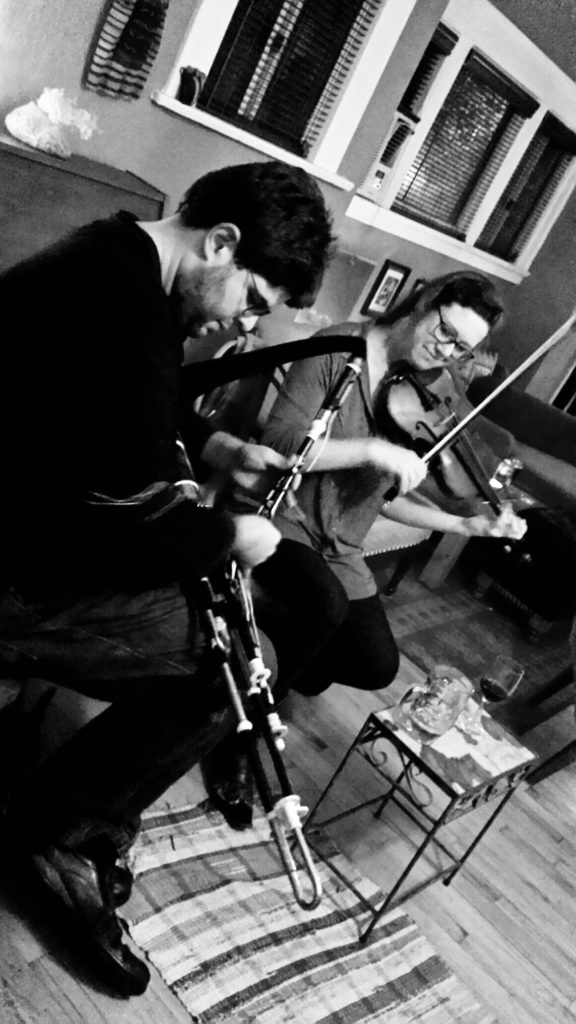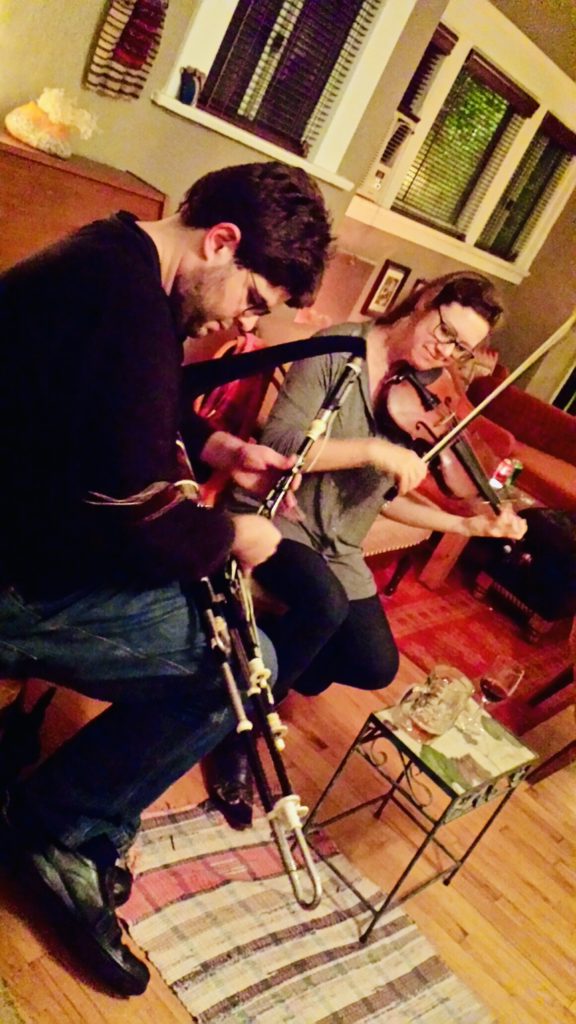A Tag Team Interview Between Principal Horn Ben Jaber and Violist Wanda Law
Hi all, Wanda and Ben here! We sat down and had a conversation about our involvement in Traditional Irish Music, where we set out to answer a few commonly asked questions as well share our own personal stories.
Ben: Do you remember how we first met?
Wanda: I was walking up to the Symphony Hall stage entrance on 8th avenue, and I got a tap on the shoulder. Ben introduced himself as the new horn player and had heard I played Irish fiddle, and said he played Irish pipes. I thought, “Great, lets get together!” Now, I’ve met many orchestra players who have a casual interest in Irish music. Some might know a few melodies, often from classical arrangements. But when Ben and I finally met up and played a few tunes, I was blown away, because he’s the real deal!
Ben: Ditto, Wanda! I was delighted to hear that someone in the orchestra played Irish music, and even more so to find that Wanda takes her fiddle playing every bit as seriously as she takes her viola playing. I’m just glad she would indulge my asking to play together in the first place! Knowing Wanda as a valued colleague, friend, and comrade has been one of the great joys of my music-playing life.
Wanda: Pipers with Ben’s skill, knowledge, and musicality are rare. The instrument is notoriously difficult, and I don’t know of any other horn player that succeeds mightily at both. Ben might be unique.
Ben: That’s very kind of Wanda to say, and I agree that all of us are unique in our own special ways. But I do think that what she and I have as a duo together is absolutely unique. There isn’t another orchestra anywhere in the world besides our San Diego Symphony with two musicians doing what we do!
Wanda: Ben, how and when did you start playing pipes?
Ben: I was born in Philadelphia and we moved to Houston when I was six. Growing up with musician parents and siblings who both played and sang, I was around pretty much every kind of music besides Classical. Rock, Rap, Country, and all the pop music of the day made up the sounds of my school days. I played piano from an early age and started playing horn when I was around ten. I was also obsessed with the pipe organ for a long time, as my Dad is an organist. I’m sure this was part of why I have any interest in bagpipes or wind/brass instruments at all. I don’t remember exactly when I first heard or became enamored with Scottish pipes or that music, but it was an instant attraction. My first real live encounters with pipes were through a family friend named Dr. Stuart Hall. Stuart is one of the most brilliant people I know. He’s a pediatric cardiac anesthesiologist at Texas Children’s Hospital in Houston and was one of the first Rice-Baylor scholars. He was admitted to Baylor Medical School right out of high school and got his degree in linguistics from Rice University in the meantime, where he learned around a dozen languages in four years. My family knows him because he sang in my Dad’s choirs at Rice, and was among a group of students from early on in my folks teaching days with whom we’ve stayed friends. Stuart grew up playing and competing with Scottish pipes, and also studied Irish Uilleann pipes. He told me all about them, before I ever saw them in pictures or in person, describing them as this complicated bagpipe that could play chords, which would’ve been mind-blowing at the time. Stuart had all the classic recordings of the great Irish pipers, which was the bug that bit me. I knew when I first heard the sound of the instrument that it was for me, the same as when I first heard the horn. This was also around the dawn of the internet, before YouTube, etc. I started out playing Scottish pipes for a while, but found I was much more drawn to Irish music in general, the more recordings I heard. Scottish pipe music is by nature very military, very martial. Think of twenty pipers playing together making that giant sound with drums in a band, and all of the music is written down with dots, so those twenty pipers can play exactly the same thing at the same time. Irish music is much freer, much more open to interpretation in the way the tunes are treated. This is part of what appealed to me, that depth of expression. Before I ever got a set of Irish pipes of my own, I started with learning tunes on the Tin Whistle, playing along to recordings. I eventually borrowed a wooden flute and got going with that sort of by accident. I heard recordings of great flute players and decided I was into that, too! With playing horn, I was already used to playing a wind instrument and the whole embouchure thing, so it sort of came naturally. I got the pipes I still play today when I first moved to Los Angeles, around 2005, which have since been rebuilt.
How about you, Wanda? How and when did you first take up fiddle playing?
Wanda: I started exploring traditional fiddle music and song in high school here in San Diego. For several summers, I performed as a member of the old globe’s “Greenshows”, mini Elizabethan dance and music dramas presented, on the now bygone grass area near the theater buildings, for patrons waiting to see Shakespeare Festival plays. I was introduced to the local Renaissance fair scene, met a bunch of fun musicians with traditional music skills, and dove in. I had opportunities to pursue my interest further while attending college in the Midwest and earning my Viola Performance degrees. On breaks, I’d return to San Diego and visit a North Park cafe called Drowsy Maggie’s where members of the Siamsa Gael Ceili Band (local musicians who had learned from an extraordinary Irish piper, Dublin native Dave Page) anchored a traditional Irish music session. While they sat around and played tune after tune, I would take my giant Radio Shack cassette machine and record. Then I’d go home and learn a few of their tunes and return the following week to gingerly play along. I ended up marrying the flute player, Ian. When I was learning, I was going to many camps, concerts, and festivals, in order to see and hear and sometimes play with more experienced traditional musicians and, most importantly, to try to absorb as much as I could from master players with authentic style. One of the best places to learn just about any kind of music you can think of is a music and dance camp in Mendocino called “Lark In The Morning”. I first went to Lark Camp in 1982 which was the 2nd or 3rd year of the camps existence. I have been going back most every summer since, and have been teaching there for much of that time. When I met Ben, I was adamant that he go to Lark Camp. At Lark, they have a motto: “Sleep is for sissies”. There’s music and dancing of every kind going on 24 hours a day, in the middle of the Mendocino Redwood Forest, and one completely loses track of time. I knew Ben would fit right in!
Ben: And to Lark Camp I went! I had heard about “Lark In The Morning” in Mendocino first through their famous instrument catalog, which was popular when I was first starting out playing Irish music. They had everything! Whistles, rainsticks, hurdy-gurdies, dulcimers, bagpipes of every sort, alphorns, you name it! I was so excited to get to go to the camp I’d heard so much about for the first time in 2013, then twice more in 2014 and 2015 when I was asked to teach. 2014 was also the summer when I first met my wife, Audrey, though we didn’t get together until years later. I thus credit Wanda for introducing me to my wife! Audrey’s been asked to teach at Lark this summer and I’m so stoked to be going back there with her. It’ll be the first summer the camp is open again since the pandemic lockdown, so I know were all looking forward to an amazing party!
So what are the instruments we play in Irish music?
Wanda: I play Fiddle, Tenor Banjo, Mandolin, and Button Accordion.
Ben: I play Uilleann Pipes, Wooden Flute, and Tin Whistle. I also own a Fiddle which Wanda gave me for Christmas. I love hearing Audrey play it!


What are some of the challenges of learning traditional Irish music?
Wanda: My husband Ian says the three most important words regarding Irish Traditional Music are: Style Is Everything. Many of the techniques and premiums of playing Classical music are not what apply to Irish music. I think of the fiddle as a different instrument than the violin. In Classical music there are many techniques and inclinations that aren’t appropriate for the style of Irish music. There are ornaments and bowings in Irish music that one never encounters in Classical music. These are things that can’t be written down with Western Music notation, so the key to learning really is through detailed listening. I never learn tunes from dots, and always learn the music by ear. Its a different memory process to learn what a tune ‘feels’ like as opposed to what it ‘looks’ like.
Ben: Ditto again, Wanda! What she’s saying certainly applies to flute playing, too. Plenty often, orchestra flute players are asked to play something in an ‘Irish’ or ‘Celtic’ style, sometimes on a Tin Whistle if possible. A lot of what makes Irish music sound the way it does has to do with articulation and phrasing, not just putting ornaments in places. These are the things that are next to impossible to write down. Irish music in its purest form is closer to Eastern music than Western. The ‘pitch collections’ that make up reels and jigs are more like the rows of notes that form Indian raga. When composers in general ask for something to be played in a certain style, musicians usually try to imitate something else they’ve heard to get it to sound more ‘authentic’, and that imitation is done by ear. Being able to play the ‘real’ music in the ‘real’ style requires regular, consistent, intimately detailed listening study, the same as learning any other language. And by listening to and being educated by the things I hear in traditional Irish music, played on any instrument, I’m able to better understand what composers of any kind are going for when I’m playing the horn in the orchestra.
Whats up with that word ‘Uilleann’? ‘You-lee-ann’? ‘Woolen’? ‘Alien’?
Ben: That’s an Irish word that means ‘elbow’. It rhymes with ‘chillin’. It’s a very exotic-sounding Irish term that was ascribed to the instrument at some point in the very early 20th Century. Before that, they were mostly known as Irish pipes. During the times of the Penal Laws in Ireland, music and dance were forbidden, so there was a need for a softer-toned instrument to be played indoors to accompany dancing, which all had to be done strictly on the hush. The pipes thus evolved out of a European parlor instrument tradition, different from the war pipes played in Scotland. They’re like a little one-man band, complete with their own accompaniment, and thereby exist in their own solo tradition. Historically, they were mostly seen and heard being played solo. Nowadays, group playing is far more common.
Where might someone have heard us?
Over the years we’ve played lots of dances (Wanda’s daughters were both Irish step-dancers), school shows, ceilidhs (pronounced ‘kay-lees’; another Irish word for ‘dance party’), concerts, parties, and many, many, many sessions! When we can, we show up at the Ould Sod Pub in Normal Heights for the regular Tuesday evening session. We’ve appeared on stage twice at Symphony Hall with the Chieftains. We both from time to time get invited to join various other bands for special projects and events. Wanda plays regularly with famed LA piper and recording musician, Eric Rigler. Ben made four trips to Ireland between 2017 and 2018, during which time he was invited to perform on the Piping Recital at the Willie Clancy Summer School in Miltown Malbay, CO. Clare.
So what exactly is an Irish music “session”?
Ben: Irish music sessions are similar to Classical chamber music parties, except no music stands! They’re also not quite the same as what might be considered a ‘jam session’, like in Jazz or Blues where one improvises over chord changes. Usually the tunes will be played in unison, with minimal accompaniment, and the improvising happens through varying the melody but staying within that framework, ‘inside the changes’, as it were. Sessions are where the music lives and thrives, where friends gather to share tunes. The repertoire is vast, infinite really, all rooted in interesting history. The names of commonly played tunes are almost insignificant, as there seems to be multiple names for most of them, usually after people or places or events. And though the repertoire is huge, with any given musician having a zillion tunes bouncing around in their head, you can go anywhere in the world where Irish music is played and have many of them in common.
Wanda: And again, no sheet music required! The etiquette of a session is perhaps interesting. Some public sessions are open to all, some are by invite. Dance tunes predominate. In general, a musician who starts a tune will continue to build a medley of two or more of the same type of tune, signaling time to change with anything from a subtle raised eyebrow to a gruff bark. If you know the tune, you can join in; if you don’t, you enjoy listening. With the exception of a spare accompanist or two (and often the music is unaccompanied; the piper’s drones and regulators can rule), everyone stays on the melody. Unlike some other forms of social music making, we don’t go around trading “hot licks”, adding harmonies, or doing grand stretches of melodic improvisation. There is definitely room for judicious improvisation and creativity, but it is within the confines of a somewhat narrow range of acceptable style. At all times, it must be able to layer easily with what the other participants are doing. It is quite remarkable that even with great individual nuance, it still sounds like we are all playing the same tune. That is part of the magic.
How do we wrap this up?
Ben and Wanda: We want to be clear by saying that for both of us, playing Irish music isn’t a hobby. That might sound a bit cliched to say, but it’s really true that playing the Uilleann pipes or the Fiddle in any serious fashion is a full-on activity that requires a lifetime of study and practice. It’s something we make time for, on top of all our responsibilities and practicing our ‘normal’ instruments! We’re both often asked which do we like better? And I think we’d agree that’s impossible to answer, as both Irish music and Classical Music are equally fulfilling and important sides of our musical lives.
The Trip to Durrow:

